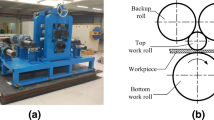Abstract
The efficiency of the flatness actuator is the cornerstone of the strip steel flatness control system and is pivotal in maintaining the quality of the strip shape and microstructure properties in commercial strip steel. However, the fluctuation in the thermal crown of the work rolls during the cold rolling process significantly impacts strip flatness quality. Obtaining real-time updates on the thermal crown alterations of the work rolls presents notable difficulties. Hence, the actual efficiency of the flatness actuator measured in the cold rolling environment fails to consider the effects of the work rolls’ thermal crown, undermining the control precision of strip shape. Exploring the mechanism through which the thermal crown of the work rolls influences strip shape is therefore crucial. This would allow for determining the efficiency of the flatness actuator, accounting for the work rolls’ thermal crown. In this research, an innovative approach is utilized, where FEM is used to create a highly accurate model. This model encapsulates the temperature-stress-strain field. This model effectively elucidates the time-varying influence of the hot roll shape on the strip shape, enabling the derivation of a dynamic strip flatness actuator efficiency curve for work roll bending and other actuators in the nonstationary rolling process. In addition, it addresses common challenges encountered in strip shape control during tandem cold rolling, such as the roll change stage and acceleration/deceleration stage.>

















Similar content being viewed by others
Data availability
The datasets used or analyzed during the current study are available from the corresponding author on reasonable request.
References
Wang PF, Yan P, Liu HM, Zhang DH, Wang JS (2013) Actuator efficiency adaptive flatness control model and its application in 1250 mm reversible cold strip mill. J Iron Steel Res Int 20(6):13–20
Hinton JL, Malik AS, Grandhi RV (2011) An airy function to rapidly predict stresses in wound metal strip having asymmetric thickness profile. Int J Mech Sci 53(10):827–838
Lenard JG, Pietrzyk M (1989) The predictive capabilities of a thermal model of flat rolling. Steel Res Int 60(9):403–406
Wang GD (1986) Flatness control and flatness theory. Metallurgical Industry Press, Bei**g
Wilmote S, Milgnon J (1973) Thermal variations of the caber of the working rolls during hot rolling. Metall Rep CRM 34:17–34
Tseng AA (1984) A numerical heat transfer analysis of strip rolling. J Heat Tran 106(3):512–517
Tseng AA, Tong SX, Maslen SH, Mills JJ (1990) Thermal behavior of aluminum rolling. J Heat Tran 112(2):301–308
Guo ZF, Li CS, Xu JZ, Liu XH, Wang GD (2006) Analysis of temperature field and thermal crown of roll during hot rolling by simplified FEM. J Iron Steel Res Int 13(6):27–30
Zhang YF, Li X, Zhao MY, Qu FQ, Zhang YH, Peng W, Zhao DW, Di HS, Zhang DH (2022) Novel analytical heat source model for cold rolling based on an energy method and unified yield criterion. Int J Adv Manuf Tech 122:3725–3738
Jiang ZY, Hu WP, Zhang XM, Liu XH, Wang GD (2004) Coupled deformation and temperature analysis of strip rolling with a local perturbation of deformation using a 3D rigid-plastic FEM. J Metall 33:29–38
Tran DC, Tardif N, Limam A (2015) Experimental and numerical modeling of flatness defects in strip cold rolling. Int J Solids Struct 69:343–349
Linghu KZ, Jiang ZY, Zhao JW, Li F, Wei DB, Xu JZ, Zhang XM, Zhao XM (2014) 3D FEM analysis of strip shape during multi-pass rolling in a 6-high CVC cold rolling mill. Int J Adv Manuf Tech 74(9-12):1733–1745
Wang QL, Sun J, Liu YM, Wang PF, Zhang DH (2017) Analysis of symmetrical flatness actuator efficiencies for UCM cold rolling mill by 3D elastic–plastic FEM. Int J Adv Manuf Tech 92:1371–1389
Wang QL, Sun J, Li X, Liu YM, Wang PF, Zhang DH (2018) Numerical and experimental analysis of strip cross-directional control and flatness prediction for UCM cold rolling mill. J Manuf Process 34-A:637–649
Zhang SH, Deng L, Zhang QY, Li QH, Hou JX (2019) Modeling of rolling force of ultra-heavy plate considering the influence of deformation penetration coefficient. Int J Mech Sci 159:373–381
Zhang SH, Che LZ, Liu XY (2021) Modelling of deformation resistance with big data and its application in the prediction of rolling force of thick plate. Math Probl Eng:2500636
Zhang SH, Deng L, Che LZ (2022) An integrated model of rolling force for extra-thick plate by combining theoretical model and neural network model. J Manuf Process 75:100–109
Funding
This study was funded by the National Key R&D Program of China (2022YFB3304800), the National Natural Science Foundation of China (No. U20A20187), and the LiaoNing Revitalization Talents Program (No. XLYC2007087).
Author information
Authors and Affiliations
Contributions
Yufeng Zhang wrote the first draft of the paper. All authors revised and approved the final version of the manuscript.
Corresponding author
Ethics declarations
Competing interests
The authors declare no competing interests.
Additional information
Publisher’s note
Springer Nature remains neutral with regard to jurisdictional claims in published maps and institutional affiliations.
Rights and permissions
Springer Nature or its licensor (e.g. a society or other partner) holds exclusive rights to this article under a publishing agreement with the author(s) or other rightsholder(s); author self-archiving of the accepted manuscript version of this article is solely governed by the terms of such publishing agreement and applicable law.
About this article
Cite this article
Zhang, Y., Zhao, M., Wang, Q. et al. Analysis of flatness actuator efficiency in thin strip steel tandem cold rolling by FEM considering the effect of time-varying work roll thermal crown. Int J Adv Manuf Technol 128, 4035–4047 (2023). https://doi.org/10.1007/s00170-023-12151-0
Received:
Accepted:
Published:
Issue Date:
DOI: https://doi.org/10.1007/s00170-023-12151-0



